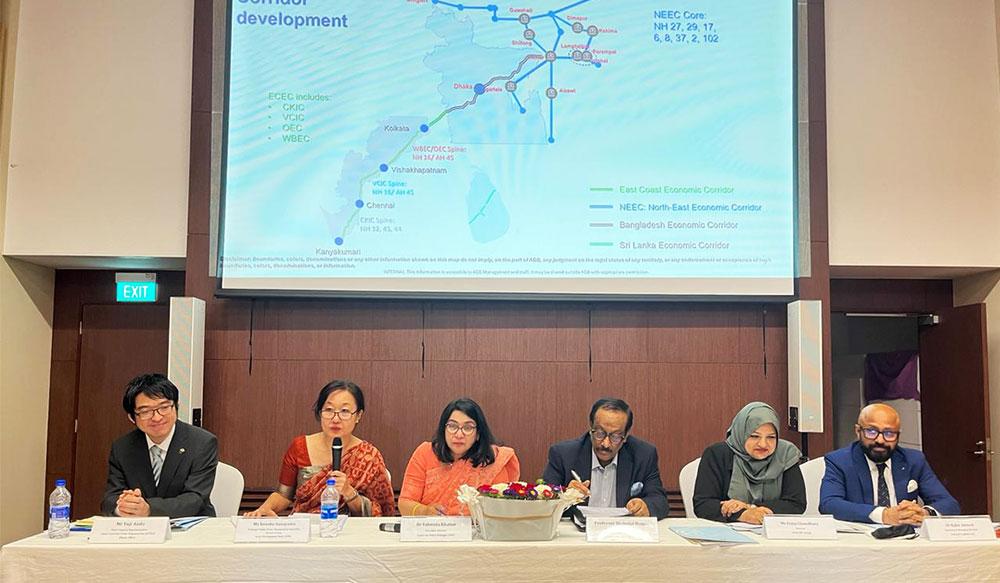
A two-pronged strategy for export diversification holds promise for the Bay of Bengal countries. One would be to focus on the products that are already close to the current specialisation patterns and require similar knowledge and technology. The second would be to take some bold steps towards more complex and technology-intensive products, particularly if doing so could open up more opportunities for trade diversification. Currently, it is of utmost importance for Bangladesh to simultaneously improve its investment and trade capacities to strengthen regional integration. Developing industrial networks and value chains can only be advanced by making transportation and trade easier.

In this context, the Centre for Policy Dialogue (CPD), in co-operation with the Embassy of Japan in Bangladesh, organised a seminar titled ‘Multi-layered Connectivity in the Bay of Bengal: Positioning Bangladesh as a Regional Economic Hub’ on Sunday, 10 March 2024. The seminar had an inaugural session, five distinctive sessions concerning multi-layered connectivity, and a closing session.
In her welcome remarks, Dr Fahmida Khatun, Executive Director, CPD, said, ‘Updating and diversifying industries is urgent, requiring action not only at the individual country level but also on a regional scale’.
His Excellency Mr Iwama Kiminori, Ambassador Extraordinary and Plenipotentiary, Embassy of Japan in Bangladesh, remarked, ‘Secure, peace, stability, and prosperity through a free and open Indo-Pacific is crucial for fostering co-operation and mutual understanding among nations in the region. In this context, expanding the circle of cooperation for enhancing regional connectivity is very important’.
In his keynote presentation, Mr Syed Yusuf Saadat, Research Fellow, CPD, recommended taking advantage of market opportunities and trade potential in neighbouring regions. Establishing trading partnerships through Regional Trade Agreements (RTAs) is essential. He added that improving the investment climate, tackling behind-the-border barriers, upgrading skills, providing financing for small and medium enterprises, and investing in trade and digital infrastructure in the Bay of Bengal economies can promote industrial value chains and establish the region as an Asian economic hub.
While giving updates on the current connectivity status by Japan International Cooperation Agency (JICA), Mr Ichiguchi Tomohide, Chief Representative, JICA, emphasised that the Matarbari port is poised to emerge as a critical gateway, serving as a central hub for energy, power, logistics, and industry. Notably, unlike much of the shallow Bay of Bengal, the waters surrounding Matarbari offer significant depth, making it a viable location in Bangladesh for a deep-sea port. With water depths exceeding 16 meters, Matarbari surpasses other ports in Bangladesh, which typically have depths of less than 10 meters. Thanks to the JICA financing, the ambitious project for a container terminal capable of handling 800,000 TEUs, a multipurpose terminal, and an access road is on track for completion by 2027.

Professor Kemmei Tsubota, Faculty of Global and Regional Studies, Toyo University, Japan, delved into the history of the development of the Mekong subregion, particularly focusing on the Greater Mekong Region. He highlighted the combination of international transport infrastructure projects and trade facilitation measures initiated by the Asian Development Bank (ADB) in 1992. This included a discussion on the various economic corridors, such as the North-South, Southern, and East-West corridors, emphasising their geographical locations and significance.
Md Mosharaf Hossain, Director, Trade, Investment and Development, Bay of Bengal Initiative for Multi-Sectoral Technical and Economic Cooperation (BIMSTEC), said, ‘At its core, BIMSTEC cooperation revolves around trade and investment’. He elaborated that member states have been actively engaged in negotiations concerning trade in goods, services, trade facilitation, customs co-operation, and investment, reaching an advanced stage of agreement. In the realm of transportation, there is a commitment to establish a seamless transport network, including initiatives such as the BIMSTEC Motor Vehicle Agreement and maritime co-operation, with expectations of imminent signing.
While discussing the importance of Bangladesh in the Bay of Bengal region, Professor Shahidul Haque, Former Foreign Secretary of the Government of Bangladesh and ICCR Bangabandhu Chair, Delhi University, emphasised the increasing importance of Bangladesh within the Bay of Bengal region and the broader Indo-Pacific context. He highlighted Bangladesh’s strategic location and growing economy, noting its role as a major player in the area. He elaborated upon discussions involving Bangladesh, India, and Japan, indicating the country’s involvement in regional affairs and its rising geopolitical significance. He underscored Bangladesh’s evolving narrative and emerging prominence within the Bay of Bengal region.
Dr. Sonoko Sunayama, Principal Public Management Specialist, Sectors Group, ADB, highlighted that within the South Asia subregion, ADB has actively facilitated co-operation through various programmes. Notably, ADB has supported the South Asia Subregional Economic Cooperation programme, under which transport connectivity, trade facilitation and economic corridor development initiatives have been realised. Collaboration between BIMSTEC and ADB is also underway, further enhancing regional connectivity and integration efforts. ADB’s conceptualisation of and investment in economic corridor development started with the East Coast Economic Corridor in India, and today include total of twelve in Bangladesh, India and Sri Lanka. She emphasised that trade facilitation and logistics development are building blocks for corridor development, and highlighted as an example, ADB’s Integrated Trade Facilitation programme in Bangladesh, which supports national and border crossings-level investment and policy reforms.
The Chief Country Representative of Japan External Trade Organization (JETRO), Mr Yuji Ando, said that the perspective of Japanese companies in Bangladesh is shaped by various factors, as highlighted in JETRO’s annual survey. While there is significant interest in investing in Bangladesh, with 61 per cent of Japanese companies expressing intent over the next 1 to 2 years. Despite investment opportunities, India holds certain advantages over Bangladesh. Challenges include the development of value chains between Bangladesh and India and issues related to infrastructure development and mutual access for vehicles. However, initiatives such as the bilateral Comprehensive Economic Partnership Agreement (CECPA) and the development of the Matarbari deep-sea port are expected to enhance connectivity and facilitate trade. Challenges persist, including poor road conditions from Shilong to Tamabil and complexities within Bangladesh’s legal and tax systems, including time-consuming tax procedures and customs clearance. Specific hurdles include an underdeveloped legal system and the need to streamline tax procedures. Bangladesh must focus on increasing its local procurement rate to establish value chains in the region.
Ms Uzma Chowdhury, Director, PRAN-RFL Group, shared insightful recommendations to boost exports in the region, particularly emphasising the untapped potential of the Bay of Bengal. She stressed the need for greater collaboration among governments and private sectors to facilitate product diversification and enhance economic value chains. She highlighted the significant cost advantage of accessing the North-East India market from Bangladesh, underscoring the region’s vast untapped potential. She recommended investments in areas crucial to the North-East region’s development to capitalise on this opportunity.
Dr Kabir Ahmed, Chairman & Managing Director of Conveyor Logistics Ltd., raised concerns regarding the readiness of the logistics sector for the full operationalisation of Matarbari. Most trade is conducted by sea, with a smaller portion by road and rail. Dr Ahmed expressed doubts about the logistics sector’s preparedness once Matarbari becomes operational. He emphasised the need for swift action, highlighting that while Matarbari will be a game-changer, additional policies regarding connectivity are necessary at the Bangladesh, Bhutan, India, and Nepal (BBIN) policy levels to leverage its advantages fully. He stressed the importance of close collaboration between the governments of Bangladesh and India to maximise the benefits of Matarbari.
In the closing session, His Excellency Mr Pranay Verma, High Commissioner of India to Bangladesh, emphasised the deepening relationship between India and Bangladesh, focussing on shared progress and prosperity. He highlighted the importance of efficient connectivity, including restoring historical routes and agreements on port usage. India pledged to facilitate Bangladesh’s access to its markets, particularly for Nepal and Bhutan, while recognising Bangladesh’s significance for India’s North-Eastern states. Additionally, he underscored Japan’s valuable partnership in these efforts. He highlighted Bangladesh as one of India’s largest markets, with the potential for significant growth through enhanced economic linkages and transport connectivity.
Mr Ahasanul Islam Titu, MP, Hon’ble State Minister for Commerce, Government of the People’s Republic of Bangladesh, emphasised the importance of exploring new markets and regional trade. He highlighted efforts to enhance infrastructure, including plans for paperless documentation in ports with support from Singapore, to reduce processing times. Acknowledging India as a key trading partner, the State Minister also underscored the significance of India’s partnership in ensuring Bangladesh’s food security.
High-level policymakers, diplomats, foreign delegates, researchers, development practitioners, academics, business leaders, civil society representatives, international development partners, and journalists participated in the seminar.



